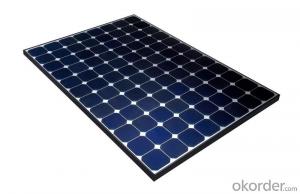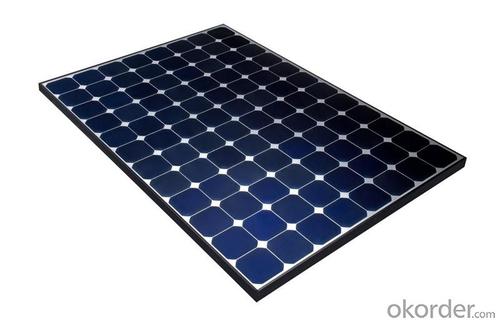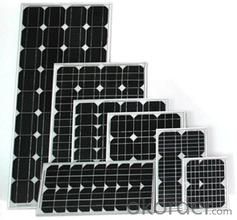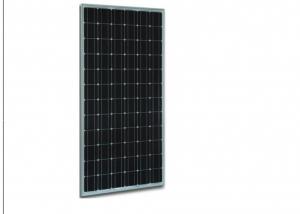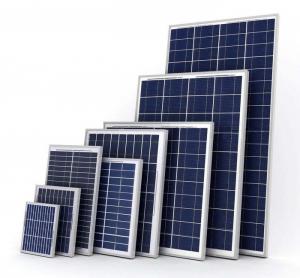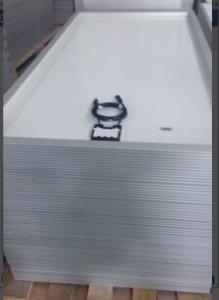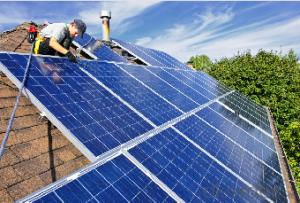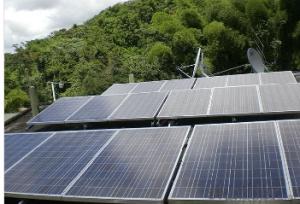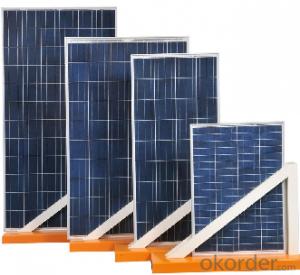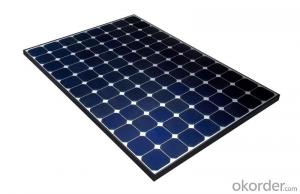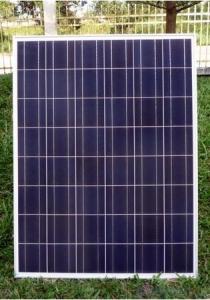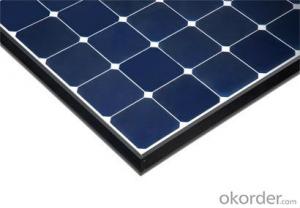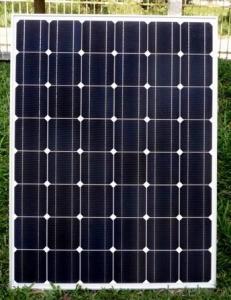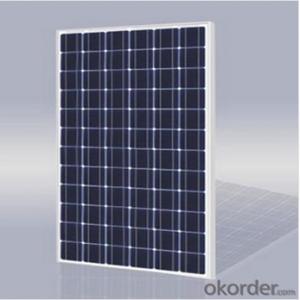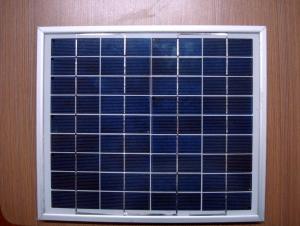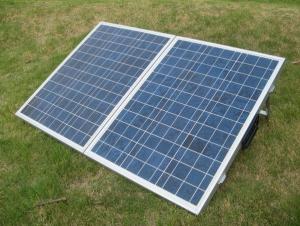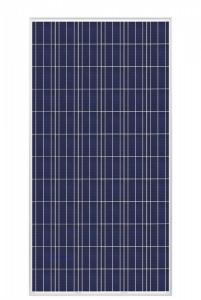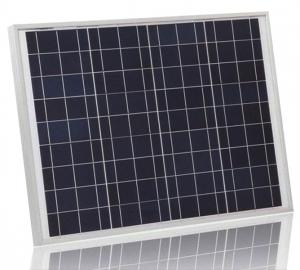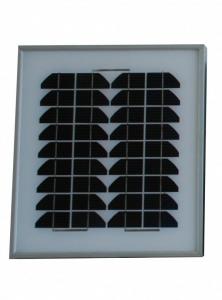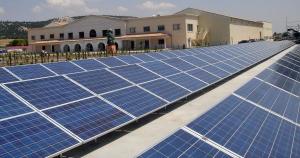Brown Solar Panels - CNBM Poly 250W Solar Panel with TUV UL CE Certificate for Residential
- Loading Port:
- Shanghai
- Payment Terms:
- TT OR LC
- Min Order Qty:
- 100 watt
- Supply Capability:
- 1000 watt/month
OKorder Service Pledge
OKorder Financial Service
You Might Also Like
Specification
CNBM Poly 250W Solar Panel with TUV UL CE Certificate For Residential
Introduction
Electrical connections are made in series to achieve a desired output voltage and/or in parallel to provide a desired current capability. The conducting wires that take the current off the modules may contain silver, copper or other non-magnetic conductive [transition metals]. The cells must be connected electrically to one another and to the rest of the system. Externally, popular terrestrial usage photovoltaic modules use MC3 (older) or MC4 connectors to facilitate easy weatherproof connections to the rest of the system.
Each module is rated by its DC output power under standard test conditions, and typically ranges from 100 to 365 watts. The efficiency of a module determines the area of a module given the same rated output – an 8% efficient 230 watt module will have twice the area of a 16% efficient 230 watt module. There are a few solar panels available that are exceeding 19% efficiency. A single solar module can produce only a limited amount of power; most installations contain multiple modules. A photovoltaic system typically includes a panel or an array of solar modules, a solar inverter, and sometimes a battery and/or solar tracker and interconnection wiring.
The photovoltaic effect was experimentally demonstrated first by French physicist Edmond Becquerel. In 1839, at age 19, he built the world's first photovoltaic cell in his father's laboratory. Willoughby Smith first described the "Effect of Light on Selenium during the passage of an Electric Current" in a 20 February 1873 issue of Nature. In 1883 Charles Fritts built the first solid statephotovoltaic cell by coating the semiconductor selenium with a thin layer of gold to form the junctions; the device was only around 1% efficient.Micro-inverted solar panels are wired in parallel which produces more output than normal panels which are wired in series with the output of the series determined by the lowest performing panel (this is known as the "Christmas light effect"). Micro-inverters work independently so each panel contributes its maximum possible output given the available sunlight.[6

Suggested application
Home lighting business lighting,
Garden lighting, pavement lighting
Farmer household lighting
Decorative water pump
Traffic signal lighting
Industry area
Business area
Solar Power Plant
Product feature
Modules are made of Monocrystalline or Polycrystalline Silicon cell.
Materials and color of the solar panel frame: Clear anodized aluminum alloy type 6063T5 Universal frame; Silver-white color;
The output connection gathers the coupling: Selects conforms to the IEC-612615; 2005, class II, IEC61730 international standard; Airtight waterproofing binding clamp;
Module seal structure: The surface is thick, the high diaphanous rate armored glass with solar cell board special-purpose 3.2mm becomes after the high temperature lamination craft. The back selects has waterproof and anti- aged performance fine TPT materials. The entire block battery board has, the waterproofing, the anti- aging airtight and so on the fine performance;
Power tolerance: +/-3%
Packaging
International standard cartons (according to the requirements of customers)
- Q: Can solar panels be used in areas with high levels of dust storms?
- Yes, solar panels can be used in areas with high levels of dust storms. However, it is important to regularly clean and maintain the panels to ensure optimal performance. Dust storms may temporarily reduce the efficiency of solar panels, but with proper care and regular cleaning, they can continue to generate electricity effectively.
- Q: How do solar panels impact the electric bill?
- Solar panels can significantly reduce or even eliminate the electric bill. By generating electricity from sunlight, solar panels can offset the amount of power needed from the grid. This means that homeowners or businesses with solar panels can consume less electricity from the utility company, resulting in lower energy bills. In some cases, excess solar energy can be exported back to the grid, earning credits that further reduce the electric bill.
- Q: Any recommendations for companies? Any things to look out for?
- Yes, solar panels are a great way to save on electricity costs for your home. 4 things I can tell you to look out for are: Make sure you can fit enough solar panels on your house to make a decent saving. If you don't have the roof space then you can't put up enough panels and you might as well not bother. For a medium sized home, I would say that you should go no smaller than 2.2kW in solar panels. If you can fit more then go for it. Make sure that the inverter that is used is big enough. It has to deal with the watts from the solar panels back to the power board to convert it as useable energy. If you have a rebate system where you live then make sure you use it. Where I am we have carbon credits that the government will give you that you use to offset the cost of purchasing solar. Don't fall for gimmicks where a company will promise you that you won't pay electricity every again. In order for that to happen you need to be putting more electricity back in the grid as you are currently using so you either need a huge amount of solar panels or you really need to cut back on what you are currently using.
- Q: Are photovoltaic cells the same as solar panels?
- All okorder
- Q: Ok so I am planning on buying a solar panel. I am doing it to possibly sell the energy that it stores. It is a 20 watt panel so I am just wondering if every week or month if I sold that energy that it stored would make me a good profit. I am not hoping for thousands of dollars a month..just like 00? The solar panel cost me $,00 so if so, how long do you think it would take to make good profit. Also, how much would I make every week or month?
- I will give you the tools to answer your own question. Here is the solar resource map: rredc.nrel /solar/old_data/nsr... Use it to look up the hours of peak equivalent sunlight per day in your area. For example, let's say it's 5 hours / day. Then per year you get 365 x 5 = 825 hours of sun Your panel is 20 watts, or 0.2 kW So the energy produced per year is 825 x .2 = 383 kWh You'll have to use the proper numbers for your own area, of course. Anyway, you can take that 383 kWh and determine how much it would cost at local electric rates. Never know, on some islands, it's $.00 per kWh. Check with your local electric company for rates.
- Q: For those solar panels that you install on your rooftops, do they generate electricity when it's cloudy? And if yes, how much electricity does it generate compared to sunny days? For example...like only 25% electricity generated compared to sunny days?
- No, silicon photovoltaics reacts to a very specific frequency of infrared light which matches the bandgap energy of it's outer electron shell. This frequency is reflected by clouds. However, thermal solar collectors such as evacuated tube collectors can function under cloudy skies albeit at a lower rate and there is at least one hybrid photovoltaic and thermal panel designed to take advantage of this.
- Q: I was watching an idiot abroad, and I saw a family that lived in tent like huts, with no plumbing. And they had a solar panel, now if they can afford it, I know I can. Where do you get cheap ones?
- We are having solar panels installed this Friday. Call a company called Solar City. You can work it through them 3 different ways, you can buy them out right and reap 00% savings, or lease them (like we are) and sign a contract. You won't pay a dime to lease them but your savings won't be as much. The plus side is, you don't have the huge expense either and they are responsible for the maintenance. Lastly, you can lease as the latter option, and purchase during any point of the lease at a pro-rata cost. You can also chose to buy the panels cheaply when your lease is up, but they may be very outdated by then. We have found Solar City top notch, highly trained, extremely polite and considerate. We found them set up at Home Depot. It took from about last January, I think it was, until this Friday, for installation, and then it will be about another 6 weeks until the service is actually turned on. Government red tape, etc. Good luck. I hope this helped.
- Q: Interested in buying solar panels to save on electric bill.Any government help plans?
- Yes, okorder / Also, realize, that installing solar is generally not an instant-save proposition. You pay thousands or tens of thousands of dollars to get the system installed, then it pays you back over the years. You need to talk with a local installer to see if the financial case makes sense in your situation.
- Q: wondering if i should get them?? not sure if its worth leasing? also anyone know anything about solar city?
- It okorder He has a modest system, and soon will be uploading some useful informaiton on cosntructing smaller solar arrays from individual small cells salvaged from various items. At some point too he will cover converting some items people would not really think of to running on 2 volts that once were 20 VAC items. I know the author.. so I get previews. If you post a question in his comments on some aspect or detail or if something is not real clear, he will try to address them too.
- Q: I would like to know how much a solar panel would cost for a wingspan of 208 ft for a plane
- Build okorder /
Send your message to us
Brown Solar Panels - CNBM Poly 250W Solar Panel with TUV UL CE Certificate for Residential
- Loading Port:
- Shanghai
- Payment Terms:
- TT OR LC
- Min Order Qty:
- 100 watt
- Supply Capability:
- 1000 watt/month
OKorder Service Pledge
OKorder Financial Service
Similar products
Hot products
Hot Searches
Related keywords
